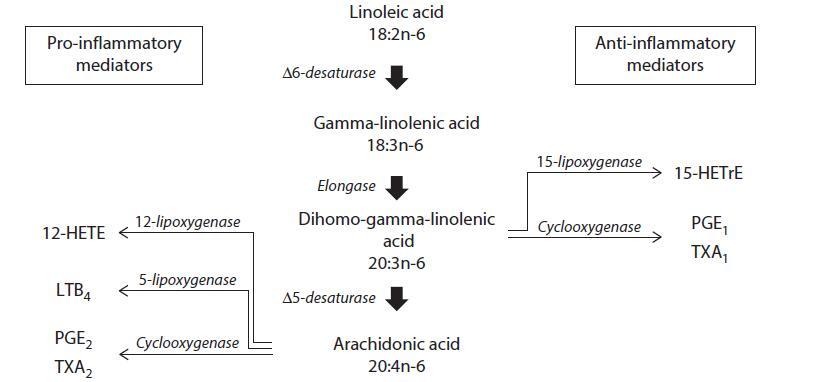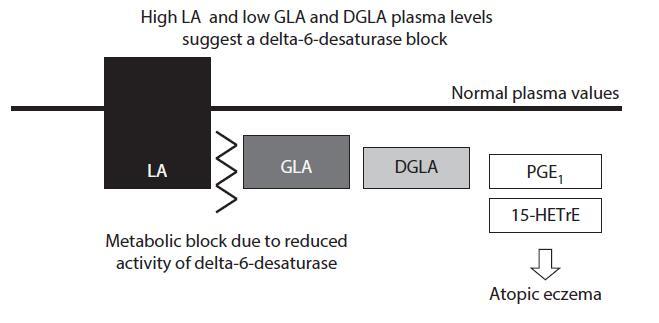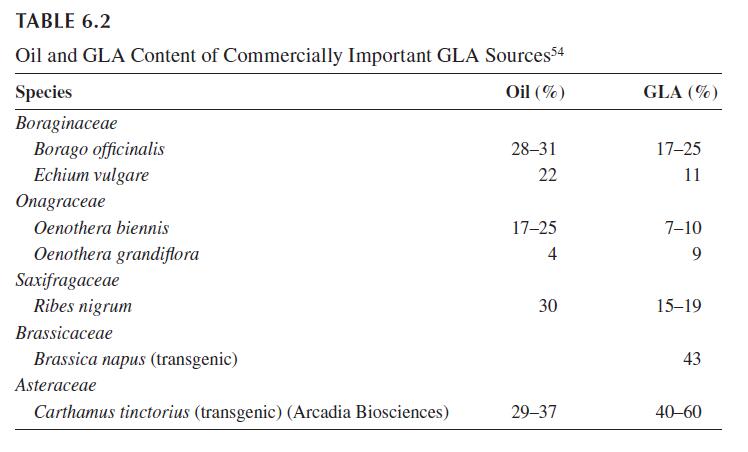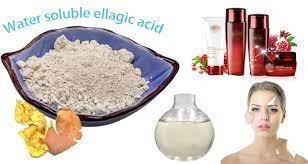Metabolism and Cutaneous Significance of Linoleic and Gamma-Linolenic Acid
Introduction
The skin, covering an area of 1.5 m2 and weighing several kilograms, is man’s largest organ. It is an important beauty attribute that determines to a large extent how others perceive us and how we perceive ourselves, and it protects the body from dehydration, mechanical insults, and environmental stressors. Lipids have varied functions in the skin. Different classes of skin lipids of diverse complexity have been identified: free fatty acids, triglycerides, sterols, waxes, ceramides, fat soluble vitamins, phospholipids, and others. Disturbances in skin lipid composition and metabolism often manifest themselves as skin problems.
Metabolism and Cutaneous Significance of Linoleic and Gamma-Linolenic Acid Epidermal hyperproliferation and increased water loss through the skin are lead symptoms in experimental and clinical fatty acid deficiency states and were key observations in the discovery of the essentiality of unsaturated fatty acids and linoleic acid (LA) in man. LA applied systemically or topically is known to regenerate a defective skin barrier in animals and in humans deficient in essential fatty acids.
Unsaturated and saturated fatty acids are components of keratinocyte and matrix lipids. Besides sterols and free fatty acids, the chief constituent of intracellular stratum corneum lipids are ceramides. LA is the most abundant polyunsaturated fatty acid in skin and has a specific role in maintaining a functional epidermal water permeability barrier of the stratum corneum. Up to 50% of LA in the epidermis is bound to ceramide-1, one of the several cutaneous ceramides that have been described.
It is thought that LA deficiency disrupts the stacked lipid bilayers surrounding the corneocytes of the horny layer, causing breakdown of the barrier function. In addition to a direct structural role, LA may also be acting through its metabolite 13-HODE (13-hydroxy-9,11-octadecadienoic acid), a major hydroxyl fatty acid in normal epidermis. Topical application of 13-HODE in an animal model of hyperproliferation reversed the hyperproliferation to a normal state4 supporting the view that 13-HODE may represent the endogenous cutaneous mediator necessary for full restoration of cutaneous symptoms of essential fatty acid deficiency.
While the importance of LA for skin health is recognized, the role of gamma-linolenic acid (GLA) is much less appreciated. GLA is an omega-6 (n-6) polyunsaturated fatty acid with 18 carbon atoms and three double bonds and represents the first product of the n-6 polyunsaturated fatty acid pathway (Figure 6.1). In mammals, GLA is converted from LA by the action of a rate-limiting enzyme, delta-6-desaturase (D6D). Once formed, GLA is rapidly elongated to dihomo-gamma-linolenic acid (DGLA), 20:3n-6, by the activity of a polyunsaturated fatty acid specific elongase. DGLA can be further converted to arachidonic acid (ARA), 20:4n-6, by the action of delta-5-desaturase. Both DGLA and ARA can be metabolized to eicosanoids, hormone-like mediators of epidermal inflammation and immune functions.

FIGURE 6.1 Biosynthesis and metabolism of gamma-linolenic acid
GLA-Rich Vegetable Oils and Skin Health
GLA-rich vegetable oils have been evaluated in a variety of clinical conditions. The oils have been reported to have a skin barrier repairing effect, to normalize excessive transepidermal water loss (TEWL), and to improve mechanical and smoothness parameters after topical or systemic administration to healthy and irritated skin. In some skin diseases GLA-rich vegetable oils were found to have preventative or ameliorative effects. These observations suggest that GLA is important in the maintenance of skin health.
Clinical Evaluation
Dry or Sensitive Healthy Skin
Dry skin is a common complaint from women and men alike. The condition is the result of an impaired barrier function resulting in an excessive loss of water through the skin. This inability to retain moisture causes the skin to look dull and flaky, feel rough, and lose elasticity. Dry skin can be due to genetic and metabolic factors and certain conditions such as dermatitis, eczema, or seborrhea.
Several intervention studies with topically or systemically applied EPO or BO have clearly shown to benefit healthy skin (Table 6.1). GLA-rich vegetable oils have been reported to have a skin barrier repairing effect, to normalize excessive TEWL, and to improve several biophysical skin parameters that serve as a measure for skin structure and function. The study by Nissen et al. deserves special mention.16 It is the only study, so far, that attempted to exclude rigorously possible confounding effects of LA. LA is present in all GLA-containing vegetable oils and has skin care and skin restorative properties. Thus, the benefits of EPO and BO could theoretically stem from the LA in these oils. The study compared a topical formulation with 3% BO (37% LA) against a formulation with 3% safflower oil (75% LA). The study revealed that application of a cream with BO strongly improves moisture content, skin roughness, and TEWL on SDS-damaged skin—more than either a cream with LA-rich safflower oil or the base emulsion alone.
Atopic Eczema
One important etiologic factor in atopic eczema is a defect of the epidermal water barrier. The skin of atopic eczema patients has a significantly lower content of ceramide-1. In addition, oleic acid has been shown to replace partially LA, leading to structural alterations of the lipid lamellae. In atopic eczema, systemic long-range adjuvant treatment with EPO has been shown to be effective. Morse and Clough17 analyzed 26 randomized, placebo-controlled clinical trials of Efamol® EPO oil in atopic eczema including 1207 patients. The meta-analysis focused on itch and dryness as the variables of primary interest. Efamol EPO was found to be a safe and effective remedy for symptomatic relief of atopic eczema with simultaneous benefits on itch/pruritus, crusting, edema, and redness (erythema) that become apparent between four and eight weeks after treatment is initiated. The magnitude of the effects appeared to be reduced with concomitant topical steroid cream usage.
In contrast, a more recent meta-analysis of clinical studies to assess the effects of EPO and BO in atopic eczema found no positive results and triggered a controversy on the possible benefits of GLA in this skin condition. No significant improvement in global eczema scores as measured by both participants and their doctors were found. Published in the Cochrane Library, the study reportedly included all randomized, controlled trials with parallel or crossover design, investigating oral intake of EPO or BO for diagnosed eczema and related symptoms in children and adults published up to August 2012. The meta-analysis included 27 studies with 1596 participants and measured no significant improvement in Global Score.
One might speculate on why the two reports arrived at different conclusions. Whereas Morse and Clough analyzed 26 studies conducted exclusively with EPO, Bamford et al. looked at a total of 27 studies of which only 19 were EPO studies, the remaining eight used BO as the active treatment and these may not necessarily be classed as the same. The GLA in EPO is primarily in the sn-3 position, and would be cleaved off the triglyceride during digestion and hence find its way into the metabolic pool. BO, on the other hand, has much more GLA at the sn-2 position, which would tend to be absorbed as the 2-monoglyceride and hence be directed into phospholipids and hence membranes. An alternative hypothesis is that the very high levels of linoleic acid in EPO compared to BO are in some way influencing the way in which the body handles the GLA as TEWL and severity of AD were reported to be negatively correlated with serum levels of LA metabolites.
A series of studies over the last decades pointed to the existence of fatty acid profile abnormalities in atopics. Plasma and serum levels of LA were found to be normal or higher, whereas levels of GLA, DGLA, and ARA tended to be lower. Similar findings have been reported in peripheral blood monocytes in atopic asthma and allergic rhinitis sufferers and in umbilical cord blood in infants at risk of atopy, where the biochemical abnormality is proportional to the IgE levels.23 Though these deviations in fatty acid composition are not consistently observed and show considerable variations, they raised the speculation that atopics suffer from a deficiency or downregulation of D6D, the enzyme that converts LA to GLA (Figure 6.2). Recently, polymorphisms in the fatty acid desaturase (FADS) gene cluster (producing D6D and D5D) have been associated with atopic diseases. These abnormalities of lipid production together with decreased production of ceramides, especially ceramide-1, are possibly the main cause for the defective epidermal water barrier that is regularly observed in atopics. Breast milk of atopic women has been reported to have low levels of LA metabolites in breast milk compared with healthy mothers. Children with atopic eczema show significantly lower levels of GLA and DGLA and these were found to correlate with the severity of the disease.

FIGURE 6.2 Atopic eczema
Other Skin Problems
Tollesson and Frithz33 studied topically applied BO in 37 children with clinically diagnosed infantile seborrheic dermatitis in an attempt to establish the significance of TEWL and water content in the stratum corneum, in active disease, and after recovery. With this regimen the children were completely free from all skin symptoms within 3–4 weeks. Twenty-five healthy children in an age-matched group without skin disorders were used as controls. Significant differences in TEWL existed between patients and controls before treatment. After treatment no significant differences were found. The authors suggested GLA to be of importance in maintaining normal TEWL and also in promoting recovery in patients suffering from infantile seborrheic dermatitis.
REFERENCES
1. Hansen HS, Jensen B. Essential function of linoleic acid esterified in acylglucosylceramide and acylceramide
in maintaining the epidermal water permeability barrier. Evidence from feeding studies with oleate,
linoleate, arachidonate, columbinate and alpha-linolenate. Biochim Biophys Acta 1985;834:357–63.
2. Feingold KR. The outer frontier: The importance of lipid metabolism in the skin. J Lipid Res
2009;50(Suppl):S417–22.
3. Wertz PW, Swartzendruber DC, Abraham W et al. Essential fatty acids and epidermal integrity. Arch
Dermatol 1987;123:1381–4.
4. Miller CC, Ziboh VA. Induction of epidermal hyperproliferation by topical n-3 polyunsaturated fatty
acids on guinea pig skin linked to decreased levels of 13-hydroxyoctadecadienoic acid (13-hode). J Invest
Dermatol 1990;94:353–8.
5. Ziboh VA, Miller CC, Cho Y. Metabolism of polyunsaturated fatty acids by skin epidermal enzymes:
Generation of antiinflammatory and antiproliferative metabolites. Am J Clin Nutr 2000;71(1
Suppl):361S–6S.
6. Calder PC, Yaqoop P, Thies F et al. Fatty acids and lymphocyte functions. Br J Nutr 2002;87(Suppl
1):S31–48.
7. Horrobin DF. Gamma-linolenic acid: An intermediate in essential fatty acid metabolism with potential as
an ethical pharmaceutical and as a food. Rev Contemp Pharmacother 1990;1:1–45.
8. Barre DE. Potential of evening primrose, borage, black currant, and fungal oils in human health. Ann
Nutr Metab 2001;45:47–57.
9. Chapkin RS, Ziboh VA, McCullough JL. Dietary influences of evening primrose and fish oil on the skin
of essential fatty acid-deficient guinea pigs. J Nutr 1987;117:1360–70.
10. Hartop PJ, Prottey C. Changes in transepidermal water loss and the composition of epidermal lecithin
after applications of pure fatty acid triglycerides to skin of essential fatty acid-deficient rats. Br J
Dermatol 1976;95:255–64.
You may like
Related articles And Qustion
See also
Lastest Price from gamma-Linolenic acid manufacturers

US $0.00/kg2025-04-02
- CAS:
- 506-26-3
- Min. Order:
- 1kg
- Purity:
- 10% 12% 20%
- Supply Ability:
- 3000 kg


